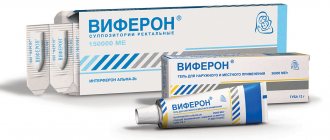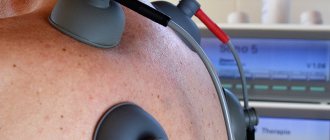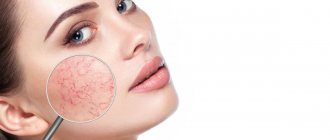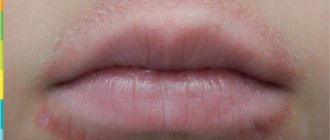Forms and complications of rosacea
Previously, several subtypes of the disease were identified according to the most pronounced skin changes: erythematotelangiectatic; papulopustular; phymatous; ophthalmic The updated guidelines suggest an individualized approach by assessing a patient's specific pattern of skin changes.
Previously, conditions such as phyma (tissue thickening, usually on the skin of the nose) and eye lesions (ophthalmic rosacea) were considered complications of the disease. Currently, they are assessed in a complex of identified changes.
Phymatous form (rhinophyma) –
Phymatous changes are called thickening of the skin (mainly in the nose area) - with the appearance of roughness, irregularities, and nodules on it. The thickening can be pronounced and then it leads to partial disfigurement of the face. Occurs more often in men, because they are less likely to seek medical help in the early stages of the disease. Thickening of the skin of the nose is called rhinophyma. Rarely, the phymatous form can be observed on the chin, forehead, cheeks, ears and eyelids.
Also, with this form, telangiectasia and hyperplasia of the sebaceous glands can occur. In the dermal layer of the skin, a dense inflammatory infiltrate is observed, in place of which then, for example, tissue proliferation and fibrosis occurs with the formation of nodes. There are several histological types of rhinophyma, for example, fibrous, glandular, fibroangiomatous, etc.
Treatment regimens for the phymatous form –
| Expressiveness | Treatment |
| Mild course - an increase in skin thickness, but without changes in contours |
|
| Moderate flow - there is a change in contours, but without a nodal component | In addition to the above:
|
| Severe flow - there is a change in contours with a nodal component |
Rhinophyma: removal of excess tissue with a CO2 laser
Causes
There are different opinions about the causes of rosacea. Vascular, immunological and hereditary mechanisms for the development of the disease are assumed, which are activated under the influence of various external influences. The triggering role of microbes and microscopic mites that live on the surface of the skin is considered; exposure to ultraviolet sunlight; possible influence of the bacterium Helicobacter pylori, which lives in the gastrointestinal tract and causes some diseases of the digestive system. The role of bacteria that inhabit the body of mites that live on the surface of the skin and normally is also discussed - since in most cases the mere presence of mites on the skin does not lead to adverse consequences for humans.
None of these factors fully explains the mechanism of development of the disease; probably, a combination of several is important.
The development of rosacea can be caused by even short-term application of hormonal creams and ointments to the facial skin. A more frequent combination of rosacea with some common diseases (inflammatory diseases of the gastrointestinal tract, metabolic disorders, some tumors) has also been revealed. Rosacea often occurs or worsens during menopause and menopause, in which case a consultation with a gynecologist may be helpful. However, such combinations do not occur in all patients, and the cause-and-effect relationship remains unclear.
Advanced stage of rosacea
Eyes with rosacea are affected quite often, and in 20% of patients, eye diseases occur even before damage to the skin. The most common eye disease that develops is blepharitis. It is characterized by redness and peeling of the skin of the eyelids, and the appearance of crusts in the corners of the eyes. Conjunctivitis may also develop: redness of the mucous membrane of the eye, which is accompanied by burning, lacrimation, painful reaction to bright light and pain. In very severe cases, complete blindness can occur.
Lack of treatment or self-medication can lead to an abscess and purulent fistulas, as well as eye disease, as we wrote above. To prevent the disease from developing complications, contact a dermatologist in a timely manner. At the Dermatology Center Petrovka 15, at your first appointment they will tell you everything about the treatment of rosacea, relieve you of the manifestations of the disease and give you up-to-date advice on prevention
Features and benefits of rosacea treatment at the Rassvet clinic
Our clinic offers patient management in accordance with the individual characteristics of rosacea, and not grouping according to previously recommended forms and stages of the disease. This allows for individualized treatment and skin care.
How is rosacea treated at the Rassvet clinic?
Before prescribing the necessary treatment, your dermatologist will examine your skin and ask questions about your condition. He will ask you to talk about the factors that (subjectively) cause deterioration; previous treatment and its effectiveness; action of drugs.
The diagnosis of rosacea is made based on an examination by a dermatologist. There are no specific laboratory diagnostic tests.
If your doctor has doubts about whether your condition fits the diagnosis of rosacea, a diagnostic skin biopsy and histological examination may be necessary.
At different stages of the disease, control of symptoms is achieved using drugs with different mechanisms of action; they can be used for a long time. If the effectiveness of the drugs decreases, the treatment regimen is adjusted by the attending physician.
The intensity of therapy may be reduced as the condition improves. In some cases, it is possible to complete it and use preventive skin care products. If an exacerbation occurs, resumption of therapy is required.
Recommendations from a dermatologist at the Rassvet clinic for patients with rosacea
- Protect your skin from sun, wind and cold.
- Do not overheat, avoid being in hot rooms.
- Avoid spicy foods and alcohol.
- Do not drink hot drinks.
- Try not to overheat while exercising; prefer exercising outside in cool weather or doing water sports.
- Eliminate irritating products from skin care - those containing alcohol, menthol, camphor or acids.
- Use gentle cleansers.
- Use skin moisturizers frequently.
- Try to avoid stress or reduce its impact.
Keeping a diary will help you identify the factors that provoke an exacerbation of rosacea in your particular case.
Papulopustular form -
The papulopustular form of rosacea manifests itself as persistent erythema in the middle third of the face, against which there are single or multiple papules or pustules (they look like pimples). Some patients may have plaques that rise above the surface of the skin. When treating this form at the first stage, the most important thing is to remove the inflammatory component, and only after that proceed to the correction of erythema or telangiectasia.
Treatment regimens for papulopustular form –
| Expressiveness | Treatment |
| Mild course - there are several papules or pustules without plaques; moderate persistent erythema is observed. |
|
| Moderate course - from several to numerous papules or pustules (but without plaques); moderate persistent erythema is observed. | |
| Severe – numerous papules or pustules with or without plaques; there is severe persistent erythema; Possible burning and tingling. | In addition to the above:
|
* The effectiveness of drugs with Ivermectin was confirmed in clinical studies “Stein Gold L, Kircik L, Fowler J, published in the journal Drugs Dermatol 2014; 13: 316-323."
Rosacea: treatment of papulopustular form (before and after photos)
Classification
There are many classifications of rosacea. Depending on the course of the disease and the intensity of the formation of skin elements, the pathology may have the following stages:
- erythematous;
- papular;
- pustular;
- infiltrative-productive.
Taking into account the clinical picture and symptoms, rosacea is divided into the following forms:
- Persistent swelling of the face.
— Ophthalmic rosacea (with this form, eye damage is observed in the form of blepharitis, conjunctivitis, iridocyclitis).
- Granulomatous rosacea (multiple elements located around the mouth and eyes, leading to characteristic symptoms in the form of many granules).
- Steroid rosacea (formed as a result of the use of local corticosteroids for a long time, while the skin is atrophic, and the elements of rosacea are brightly colored).
- Gram-negative rosacea (the name comes from secondary gram-negative microflora, which leads to pustular lesions of the skin and hair follicles).
— Conglobate rosacea (severe form of the disease, characterized by the formation of drain cavities and abscesses).
— Lightning-fast course of rosacea (observed in young women, has a fast and violent course).
— Halogen-induced rosacea (activation of the process occurs as a result of the influence of halogen-containing substances, such as iodine).
— Rhinophyma and other fibrotic changes in the skin of the face.
Types of rosacea: clinical picture of the disease
Today, the international classification of rosacea , which was developed by the expert committee of the National Rosacea Society (The National rosacea society, 2002), and includes 4 subtypes and 1 variant of the disease.
Subtype I - erythematotelangiectatic rosacea
Typically, subtype I begins with liquid erythema, which can last from several minutes to several hours. The process is accompanied by a feeling of heat, and is characterized by swelling of the central part of the face, burning and paresthesia in the affected area.
These symptoms often intensify if the patient takes spicy/hot food or alcohol; during physical activity or water treatments with hot water.
Subtype II - papulopustular rosacea
Patients with subtype II notice the periodic appearance of red, hard “nodules” on the skin of the face - papules, against the background of hyperemia in the forehead and cheeks (the periorbital zones remain clear of rashes).
This type of rosacea tends to develop simultaneously with or after type I.
III subtype - hypertrophic or phymatous rosacea
Phymatous rosacea affects more areas of the facial skin (nose, forehead, chin, cheeks and ears). The subtype is characterized by an increase in the thickness of the epidermis and the appearance of knobby growths of soft tissue in these areas.
IV subtype - ophthalmic rosacea
This rosacea is dangerous because it affects the eyelids and eyeball of a person. The patient feels dryness, painful sensitivity to light, blurred vision, and burning. The eye area is characterized by redness (hyperemia) and swelling of the periorbital zone.
Such symptoms are diagnosed together with an ophthalmologist.
A separate type is granulomatous rosacea.
This type of rosacea provokes the formation of epithelioid cell granulomas (they have a grayish-yellow tint on diascopy). Granulomatous rosacea usually develops in patients with HIV infection, tuberculosis and other severe, chronic diseases.
Vascular forms of rosacea occupy first place and account for 80% of all cases of the disease, and 20% for all others, namely papulopustular and infiltrative.
Acne symptoms
- Pimples, blackheads, whiteheads, or deep, painful cysts
- Redness. Occurs only around rashes
- Oily T-zone. Affects the nose, chin and forehead
- Uneven skin texture due to blemishes and scars
Acne is a common chronic inflammatory disease. More than 90% of the world's population suffers from this lesion at various times in their lives. Cutibacterium acnes is a bacteria that lives on the skin, but not all of them cause acne. Acne affects people of all ages, races and ethnicities, but is most common in teenagers and young adults. Acne is characterized by a variety of skin lesions: whiteheads, papules, pustules, cysts and nodules. Blackheads are usually the predominant form of acne-related skin lesions. Acne causes the skin to become oily, especially on the forehead, nose and chin.
Acne can also cause redness of the skin, which is localized around the main areas of the skin rash. Uneven skin texture due to blemishes or scars may also appear after acne has cleared. The skin condition usually affects the face, chin, neck, upper back, chest and shoulders and therefore requires immediate acne treatment.
Abstract Rosacea is a chronic inflammatory skin disease that is divided into 4 subtypes: erythematotelangiectatic, papulopustular, phymatous and ophthalmic rosacea. Goal To consider different types of treatment for all subtypes. Methods The authors of the article divided the treatment of rosacea into three main categories: patient education, skin care, and pharmacological/procedural measures. Results Redness is better prevented than treated by avoiding specific triggers and reducing transepidermal water loss through moisturizers and photoprotectants. Nonselective β-blockers and α2-adrenergic agonists reduce erythema and facial flushing. The topical α-adrenergic agonist 0.5% brimonidine tartrate reduces persistent facial redness. Intradermal injections of botulinum toxin are virtually safe and effective for the treatment of erythema. Laser-pumped dye lasers, potassium titanyl phosphate and pulsed dye laser, intense pulsed visible light are used for telangiectasias. Metronidazole 1% cream and azelaic acid 15% cream are used to reduce the severity of erythema. To treat papulopustular rosacea, both systemic and topical treatments are used. Systemic agents include metronidazole, doxycycline, minocycline, clarithromycin, and isotretinoin, while topical agents include 0.75% metronidazole, 20 or 15% azelaic acid, sodium albucid, 1% ivermectin, 5% permethrin, and retinol. Ophthalmic rosacea can be treated with systemic or topical antibiotics. Rhinophyma can be corrected through dermatosurgical procedures, decortication, and various types of lasers.
Introduction
Rosacea is a chronic inflammatory disease that affects 10% of the population. The prevalence of rosacea is highest among fair-skinned people. A committee of 17 medical experts around the world identified four subtypes of rosacea. These include:
- Subtype 1 - Erythematotelangiectatic: characterized by facial flushing and persistent erythema; may also include visible blood vessels;
- Subtype 2 – Papulopustular: characterized by persistent redness with transitional papules and pustules.
- Subtype 3 - Phymatous: characterized by thickening of the skin, which often results in an enlarged nose from excess tissue;
- Subtype 4 -Ophthalmic rosacea: characterized by ocular manifestations such as dry eyes, tearing and burning, swollen eyelids, recurrent styes and leading to potential vision loss from damage to the cornea.
Many patients experience symptoms of more than one subtype at the same time, and just as often one subtype can progress to another. While rosacea can change from one subtype to another, each individual sign or symptom can progress from mild to severe. Therefore, early diagnosis and treatment are recommended. Treatment is targeted based on patient subtype. Patients who believe that they have frequent episodes of flushing or have a family history of rosacea are advised to avoid physiological and environmental irritants that may cause increased facial flushing. Topical agents such as metronidazole, azelaic acid, ivermectin, or sulfur are effective in the management of rosacea [1].
Patients with erythematotelangiectatic and papulopustular rosacea may benefit from the use of systemic antibiotics such as tetracycline, and in severe or persistent cases, isotretinoin may be used to better control the rosacea. Patients with ocular involvement may have a long course of antibiotics and use of metronidazole gel. A surgical alternative, i.e. laser therapy, is recommended for the treatment of telangiectasia and rhinophyma. Topical α-adrenergic agonists and cosmetic camouflage may be considered to cover signs of rosacea [2].
The manifestations of rosacea on the facial skin can have a significant impact on the patient's well-being, as well as social and emotional health. Patients with rosacea have reported experiencing negative effects such as low self-esteem, low self-confidence, and decreased social interactions. Improving the clinical symptoms of rosacea improves the patient's emotional well-being and quality of life. Since there is no cure for rosacea, patient management and treatment regimens are designed to suppress the inflammatory lesions, erythema and, to a lesser extent, telangiectasia associated with rosacea. With a wide variety of systemic and topical agents available to effectively treat rosacea, patients no longer need to feel embarrassed about their condition. This article provides a brief overview of the treatment and management of rosacea and focuses on three main categories: patient education, skin care, and pharmacologic/procedural interventions.
Erythematotelangiectatic subtype of rosacea
The erythematotelangiectatic subtype of rosacea is characterized by a transient episode of facial flushing and persistent central facial erythema. Diffuse facial erythema is a common finding in patients with rosacea and may subsequently lead to persistent erythema. Redness may also include the ears and upper chest; the periorbital area is usually free of erythema; Telangiectasia is also a symptom.
Avoidance of stimuli
Redness is better prevented than treated, so patient education should be done. Patients who believe that they often have episodes of redness or have a family history of rosacea are advised to avoid physiological and environmental stimuli such as: - environmental stimuli: exposure to changes in temperature, both high and low, movement to a warm or hot environment from a cold one , cold wind, heat from sunlight and severe sunburn; -emotional stimuli: stress and anxiety; -physiological irritants: certain foods and drinks, including alcohol, caffeine, spicy foods; physical exercise; exogenous irritants: microdermabrasion, chemical peels, and products containing alcohol, menthol, peppermint, eucalyptus, clove oil and other irritants [2].
Skin care
Proper skin care plays an important role in maintaining remission and relieving rosacea symptoms. Moisturizers are an important aspect of rosacea treatment because the skin has increased transepidermal water loss in rosacea. Blocking ultraviolet light is very important; Using sunscreens reduces the production of LL-37 and subsequent production of reactive oxygen species, which can trigger rosacea.
Drug treatment
Topical α-adrenergic receptor agonists reduce persistent facial redness in rosacea due to a vasoconstrictor effect on dermal blood vessels. Brimonidine tartrate 0.5% is approved in the United States for the treatment of erythema in rosacea. Oxymetazoline also significantly reduces erythema in patients with rosacea [3].
Non-selective β-blockers, in particular atenolol, reduce erythema and hot flashes; the α2-adrenergic receptor agonist clonidine also has this effect. β-blockers are used to treat various cardiovascular diseases. Due to their vasoconstrictor effect on cutaneous blood vessels, they have reduced erythema and flushing in some rosacea sufferers. Several reports have suggested the effect of β-blockers in the treatment of rosacea. Non-selective β-blockers constrict blood vessels thought to be by inhibiting β-adrenergic receptors on the smooth muscle that surrounds blood vessels [3,4].
Clonidine in doses of 0.05 mg twice a day leads to a decrease in the appearance of redness. There is no reduction in blood pressure at this dose, but it has been noted that there may be a reduction in baseline malar temperature due to peripheral vasoconstriction. Although some patients respond remarkably well to clonidine, responders are not clinically identified before treatment. Since controlling this function of rosacea is very difficult, a trial course may be used [4].
Treatments: laser, intense pulsed light and botulinum toxin injections
Various lasers are used to treat rosacea. A long-pulse lamp-pumped laser (1064 nm in length) and a potassium titanyl oxalate phosphate laser are used in the treatment of facial telangiectasia [4]. Treatment of rosacea using new generation lasers, high energy, 595 nm pulse length improves the course of rosacea with a very favorable safety profile in contrast to earlier generation lasers. New V-beam capabilities provide an ultra-long, sustained pulse to target blood vessels. This reduces purpura and can also lead to the repair of broken blood vessels associated with rosacea, which is a more convenient method for patients [5]. The long-pulse neodymium yttrium aluminum garnet laser is a safe and effective treatment for the vascular and inflammatory lesions of rosacea.
Intense pulsed light is safe and effective for the treatment of rosacea [7]. It is a non-invasive and non-ablative treatment that uses pulses of high-intensity visible light to improve the appearance of rosacea vascular lesions. Intense pulsed light is a pulse of light that targets red pigment in the blood, which heats and destroys the pigment without affecting the skin or other tissues. Intense pulsed light (540–950 nm) is a safe and effective treatment for rosacea-associated erythema [8].
Several recent reports show possible effects of botulinum toxin on erythema. Botulinum toxin works as a neuromodulator at the neuromuscular junction. Chemical denervation with botulinum toxin interferes with normal acetylcholine signaling pathways and may provide symptomatic relief to patients with severe facial flushing. Botulinum toxin injections can be an effective and virtually safe therapy for patients with refractory erythema and may be considered a reasonable addition to therapeutic options, especially if other treatments have failed [9].
Papulopustular subtype of rosacea
The papulopustular subtype of rosacea is characterized by persistent central facial erythema and inflammatory papules and pustules that are transient.
Skin care
Skin care and avoidance of specific triggers or aggravating factors such as wind, spicy foods, alcohol, hot drinks, ultraviolet light, physical or psychological stress, and medications also play an important role in the treatment of this subtype.
Drug treatment
Topical sodium albucid, 10% sodium albucid with 5% sulfur, is effective in treating patients with rosacea, especially those with comorbid seborrheic dermatitis. Efficacy of sodium albucid has been reported for papulopustular rosacea. It helps reduce inflammatory rashes and redness of the skin. The most common adverse reactions after its use include dryness, erythema and irritation at the application site, which leads to a decrease in the frequency of use [3.]
Topical metronidazole 1 and 0.75% is considered effective in the treatment of rosacea due to its ability to reduce phagocytic generation of reactive oxygen species and dormant production of reactive oxygen species. It has been used as a topical treatment for rosacea for decades. Metronidazole is effective in reducing erythema, papules, and pustules in several studies in patients with moderate to severe rosacea. 0.75 and 1% cream were equally effective in reducing erythema, papules and pustules when applied once daily, and were also shown to maintain remission after cessation of treatment. Overall, topical metronidazole appears to be safe and well tolerated. Irritation and dermatitis are the most commonly observed adverse reactions [10].
Azelaic acid 15% gel and 20% cream were shown to reduce the expression of kallikrein 5 and cathelicidin, two important components of the inflammatory cascade in rosacea. Studies have shown that 70-80% of patients using azelaic acid reported complete remission or significant improvement in rosacea symptoms. Daily use of azelaic acid is effective and usually well tolerated. Irritation, dryness and short-term burning are the most common adverse reactions [10].
Topical ivermectin 1% cream is a new drug for the treatment of papulopustular subtype of rosacea. It kills demodex, which is found in the hair units of patients. The mechanism of its action in rosacea is unknown, but it has an anti-inflammatory effect, reduces cellular and humoral immunity, including neutrophil phagocytosis and chemotaxis, and also regulates TNF-α, interleukin-IL-1b and IL-10. Inflammatory mechanisms appear to play a dominant role in the development of papules and pustules in rosacea [11,12]. Ivermectin 1% cream showed a significant reduction in inflammatory lesions. The most common side effects are irritation, dryness and burning.
Topical retinoids are indicated to restore photodamaged skin by stimulating connective tissue remodeling and downregulating Toll-like receptors. It has been suggested that topical retinoids may be effective in reducing the symptoms of rosacea by altering the effect of ultraviolet radiation and reducing Toll-like 2 receptors [13]. Several studies have reported clinical improvement in erythema, papules and pustules, and telangiectasia, but with the potential for irritation [13,14].
Topical calcineurin inhibitors may be effective in reducing the symptoms of rosacea due to their ability to inhibit T cell activation, thereby preventing the release of proinflammatory cytokines. Calcineurin inhibitors have been used to treat papulopustular type rosacea and redness, and resulted in significant improvement in erythema in open studies, but with the potential for irritation [15]. Permethrin cream 5% was effective in treating demodicosis of the skin and reducing erythema and papules, but did not show an effect on pustules and telangiectasia [16].
Praziquantel ointment 3% twice daily significantly reduces the number of papules and pustules in patients with rosacea. This agent has the ability to treat cutaneous demodicosis as an antiparasitic agent and also has anti-inflammatory activity [17].
Systemic drugs
Tetracyclines have been the mainstay of systemic therapy for rosacea for decades. Anti-inflammatory doses of doxycycline <50 mg daily improve rosacea by reducing matrix metalloproteinase expression, downregulating inflammatory cytokines, reducing reactive oxygen species, and inhibiting nitric oxide-mediated vasodilation. It is suggested that the anti-inflammatory effects of tetracyclines are the main mechanism of action for reducing the symptoms of rosacea [3,18.]
Erythromycin is an effective antibiotic in the treatment of the papulopustular subtype of rosacea, but its use is often limited to gastrointestinal disorders. Erythromycin 250 mg/day is generally used in patients who cannot tolerate tetracyclines and in pregnant women in whom tetracyclines are contraindicated.
Oral metronidazole 200 mg twice daily has been shown to be effective in treatment but has been associated with rare potential side effects such as neuropathy and seizures [19,20].
Isotretinoin may be effective in treating patients with severe, uncontrolled papulopustular rosacea by downregulating Toll-like 2 receptors. Although it has not been approved for the treatment of rosacea, several studies have shown that isotretinoin at a dose of 0.5 to 1.0 mg/kg per day is effective for the treatment of severe forms of rosacea [21], however, studies have also shown that low doses of isotretinoin (10 mg per day) are effective in treating refractory rosacea with fewer side effects [22].
Emerging Treatments
Topical serine protease inhibitors may be effective in the treatment of papulopustular rosacea because they inhibit the breakdown of the cathelicidin precursor LL-37, an active form of the molecule that plays a role in the pathogenesis of rosacea [23,24]. Cromolyn sodium (4% solution), a mast cell stabilizer, may be used in the treatment of rosacea because mast cells release known rosacea triggers such as LL-37, matrix metalloproteinases, and inflammatory cytokines. Therefore, blocking mast cell degranulation may be a potential therapeutic target for rosacea [3,25].
Ophthalmorazcea
Ophthalmic rosacea is an inflammation that causes redness, burning, photophobia and itching of the eyes. It develops in people suffering from rosacea. Sometimes ophthalmic rosacea is the first sign of what may subsequently develop with a transition to the skin of the face. Medication and good eye care can help control signs and symptoms.
Eye care
A good eye care routine is very important, such as washing your eyes at least twice a day with warm water and using artificial tears to relieve dry skin. Avoid makeup or use non-comedogenic, fragrance-free cosmetics; in addition to skincare, avoid triggers such as hot and spicy foods, alcoholic beverages, and sunlight.
Pharmacological treatment
Tetracyclines are the most common and effective, not primarily antibiotics, but through their secondary effect they have on the meibomian glands. Tetracyclines reduce bacterial lipase; thus, they are an effective means of protecting the cornea from impending perforation secondary to inflammatory reactions [26].
Topical antibiotics
Erythromycin 1% eye drops have also gained popularity in the treatment of ocular rosacea, as it often leads to severe blepharitis and meibomian gland dysfunction.
Topical cyclosporine is more effective than oral doxycycline. Cyclosporine was more effective in relieving symptoms and treating the eyelids (p = 0.01). There was a statistically significant increase in mean Schirmer in the cyclosporine treatment group compared with the doxycycline treatment group (p < 0.05) [27].
Clarithromycin and metronidazole have also shown effectiveness in the treatment of ocular rosacea. A preliminary study has shown that these topical medications are safe and effective in the treatment of ocular rosacea [28].
Phymatous subtype of rosacea
The phymatous subtype of rosacea is characterized by thickening of the skin, which often leads to an enlarged nose from excess tissue and overgrowth of sebaceous glands. It can affect the chin or cheek, as well as the forehead. Ignoring the signs of rosacea can lead to the phymatous subtype with a puffy look. This type of rosacea is very rare, perhaps because many patients begin treatment in the early stages.
Systemic isotretinoin
Isotretinoin (0.3 mg/kg/day) may be effective in treating the phymatous subtype. It is an effective and well-tolerated treatment option by significantly reducing cutaneous blood flow and sebaceous gland growth [29].
Surgical and other procedures
Fortunately, surgical procedures can help reshape the nose and bring the skin back to its normal size by removing excess layers of skin. It takes about a week for the skin to heal after surgery and about 6 weeks after the procedure, the skin will look smoother and healthier.
CO2 laser
The CO2 laser is the preferred and most common treatment for thickened skin - a powerful laser to remove thickened skin. This procedure causes the least amount of bleeding since the laser seals the blood vessels, however, with traditional fully ablative CO2 laser, there is a risk of hypopigmentation and hyperpigmentation [30].
Light based therapy
This therapy has had some good results, but it is not enough.
Dermabrasion
This method involves using a wire brush to remove or "sand out" unwanted areas of skin, but this may cause bleeding and there is a risk of scarring and permanent discoloration of the skin [30].
Electrocoagulation
This procedure involves using a heated electrode to remove excess skin to give it a smoother appearance, but this may cause bleeding.
Stages of treatment
- Patient education: avoidance of environmental irritants (sun, extreme temperatures), emotional irritants (stress and anxiety), physiological irritants (alcohol, caffeine, spicy foods, exercise);
- Skin care (photoprotective creams and moisturizers) and eye care (artificial tears, eye washes);
- Subtype 1: the first step is local treatment (metronidazole, calcineurin inhibitors, α-adrenergic receptor agonists 0.5%, retinoids); the second stage of the procedure (laser, intense pulsating light and intradermal injections of botulinum toxin), and the third stage, oral medications (clonidine or atenolol);
- Subtype 2: the first step is local treatment (metronidazole 0.75%, azelaic acid 15%, ivermectin 1%, sodium albucid, retinoids, or calcineurin inhibitors); second step, systemic antibiotic (doxycycline <50 mg daily, erythromycin 250 mg/day, or oral metronidazole 200 mg); third step, isotretinoin 0.5-1.0 mg/kg per day, and fourth step, procedures (laser, intense pulsed light);
- Subtype 3: first step - isotretinoin 0.5-1.0 mg/kg daily; second step, CO2 laser, and third step, surgical procedures (dermabrasion and electrocoagulation);
- Subtype 4: first step, topical metronidazole; the second step, a systemic antibiotic (doxycycline <50 mg daily, erythromycin 250 mg/day, or oral metronidazole 200 mg twice daily), and the third step, erythromycin 1% eye drops, topical cyclosporine, or clarithromycin.
Conclusion
Management of rosacea focuses on three main categories: patient education, skin care, and pharmacologic/procedural interventions. Each stage has its own treatment. Patient education on skin care and medication management all underpin effective and comprehensive management through both standard and novel pathways, focusing on patient education and skin care to improve symptom control and improve quality of life for patients with rosacea.
Patients who believe that they have frequent episodes of flushing or have a family history of rosacea are advised to avoid physiological and environmental irritants such as: Patients with erythematotelangiectatic and papulopustular types of rosacea may benefit from the use of systemic antibiotics such as tetracycline, and in severe or persistent cases, isotretinoin can be used to better control the course of rosacea.
Patients with ocular involvement may have a long course of antibiotics and use of metronidazole gel. A surgical alternative, i.e. laser therapy, is recommended for the treatment of telangiectasia and rhinophyma. Topical α-adrenergic agonists and cosmetic camouflage may be considered to cover signs of rosacea. Our knowledge of rosacea and its therapeutic options are expanding, and a comprehensive approach to treatment is warranted.
Diagnostics
The basis of diagnosis is a dermatological examination using modern techniques (dermatoscopy), analysis of patient complaints and anamnesis data. Key signs include persistent redness of the face and skin around the eyes, lasting more than three months. It is important to evaluate all criteria of the disease; at least 2-3 of them must be identified to make a diagnosis. To exclude complications and similar pathologies, instrumental and laboratory diagnostics are performed.
The doctor will tell you in detail what tests to take if you suspect rosacea. The following procedures can be performed:
- skin scraping for microscopic examination (detection of demodex mites);
- cultures of discharge from pustules with determination of pathogenic flora;
- blood tests to exclude autoimmune and systemic pathologies;
- Ultrasound of the skin with assessment of the general condition, identification of infiltrates, determination of the thickness of the layers;
- Doppler sonography with assessment of hemodynamics and blood flow velocity in tissues.
Today it is also possible to perform confocal laser scanning microscopy. This is a method of non-invasive assessment of skin thickness up to 400 microns in order to study the structure of the skin, assess the condition of capillaries, and identify demodex mites.










